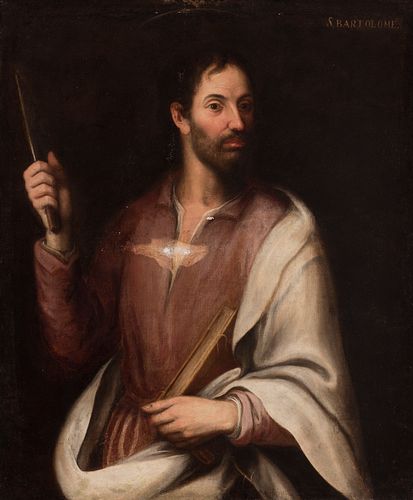Andalusian School; XVII century. "Saint Bartholomew". Oil on canvas.
Lot 21
About Seller
Setdart Auction House
Carrer Aragó 346
Barcelona
Spain
Setdart Subastas was born in 2004 and is currently the first online art auction in Spain with solidity, prestige and reliability guaranteed by our more than 60,000 users. Setdart has a young, dynamic and enterprising team ready to successfully manage the purchase and sale of art works through custom...Read more
Estimate:
EUR€1,200 - EUR€1,500
$1,290.32 - $1,612.90
Absentee vs Live bid
Two ways to bid:
- Leave a max absentee bid and the platform will bid on your behalf up to your maximum bid during the live auction.
- Bid live during the auction and your bids will be submitted real-time to the auctioneer.
Bid Increments
| Price | Bid Increment |
|---|---|
| EUR€0 | EUR€10 |
| EUR€200 | EUR€25 |
| EUR€500 | EUR€50 |
| EUR€1,000 | EUR€100 |
| EUR€3,000 | EUR€200 |
| EUR€5,000 | EUR€500 |
| EUR€10,000 | EUR€1,000 |
| EUR€20,000 | EUR€2,000 |
| EUR€50,000 | EUR€5,000 |
About Auction
By Setdart Auction House
Nov 3, 2021
Set Reminder
2021-11-03 08:00:00
2021-11-03 08:00:00
America/New_York
Bidsquare
Bidsquare : OLD MASTERS
https://www.bidsquare.com/auctions/setdart-auction-house/old-masters-7786
Setdart Auction House sofia@setdart.com
Setdart Auction House sofia@setdart.com
- Lot Description
Andalusian School; XVII century. "Saint Bartholomew". Oil on canvas. It presents humidity stains and small chromatic faults. Needs restoration. Measurements: 115 x 95 cm; 132 x 113 cm (frame). Saint Bartholomew was one of the apostles of Jesus, and is mentioned in the Gospels always in company of Philip. According to John, in whose Gospel he appears under the name of Nathanael, he was one of the disciples to whom Jesus appeared at the Sea of Tiberias after his resurrection. According to the Acts of the Apostles, he was also a witness to Jesus' ascension. The tradition collected by Eusebius of Caesarea narrates that Bartholomew went to preach the Gospel in India, where he left a copy of Matthew's Gospel in Aramaic. The Armenian tradition also attributes to him the preaching of Christianity in the Caucasian country, together with St. Jude Thaddeus, so both are considered patron saints of the Armenian Apostolic Church. Their martyrdom and death are attributed to Astiages, king of Armenia and brother of King Polymius, whom the saint had converted to Christianity. As the priests of the pagan temples, who were running out of followers, protested to Astiages against the evangelizing work of Bartholomew, the ruler sent for him and ordered him to worship their idols, as he had done with his brother. Faced with the saint's refusal, the king ordered him to be flayed alive in his presence until he renounced God or died. The image of Saint Bartholomew has undergone few modifications throughout the history of art, being common the representation of the saint at the moment of martyrdom. Thus, he is usually represented being flayed, either on a colt or tied to a tree. He has also been depicted working miracles: resurrecting the children of King Polymius and freeing his daughter possessed by the devil. On rare occasions he appears being scourged. Sometimes he is represented with a large knife alluding to his martyrdom, according to which he was flayed alive, which is why he is the patron saint of tanners. Also in relation to his martyrdom, he sometimes appears skinned, showing his skin held in his arm as if it were a piece of clothing. Aesthetically this work is close to the models of Sebastián Martínez Domedel Jaén, around 1615 - Madrid, 1667), follower of the school of Murillo is located by Palomino in Jaén, training with Antonio García Reinoso. He would arrive in Madrid after Velázquez died (so it would not have been possible for him to learn with him), city in which he would die in 1667, without means. Experts suppose that he may have studied in Cordoba, in the workshop of Juan Luis Zambrano, or with Antonio del Castillo (which would explain his dedication to landscapes), although it is possible that he was trained in Jaen, as already mentioned. A trip to Madrid in 1661 is documented, to visit the Royal Collections of El Escorial, commissioned by the cathedral chapter of Jaén, with the aim of copying some painting for the Altarpiece of the Holy Face of that building. Some documented works of the master are preserved, which show an eclectic and somewhat uneven artist, who frequently used prints for his inspiration and copied, with some skill, old masters, also imitating some of his contemporaries. It is possible to find paintings by him in several private collections, mainly Spanish, as well as in the Church of San Ginés in Madrid, in the convent of Corpus Christi in Córdoba, in the Museum of Jaén, in the Prado Museum in Madrid, in the Cathedral of Jaén, etc.
- Shipping Info
-
In-house shipping available. Please inquire at admin@setdart.com.
-
- Buyer's Premium



 EUR
EUR CAD
CAD AUD
AUD GBP
GBP MXN
MXN HKD
HKD CNY
CNY MYR
MYR SEK
SEK SGD
SGD CHF
CHF THB
THB

















